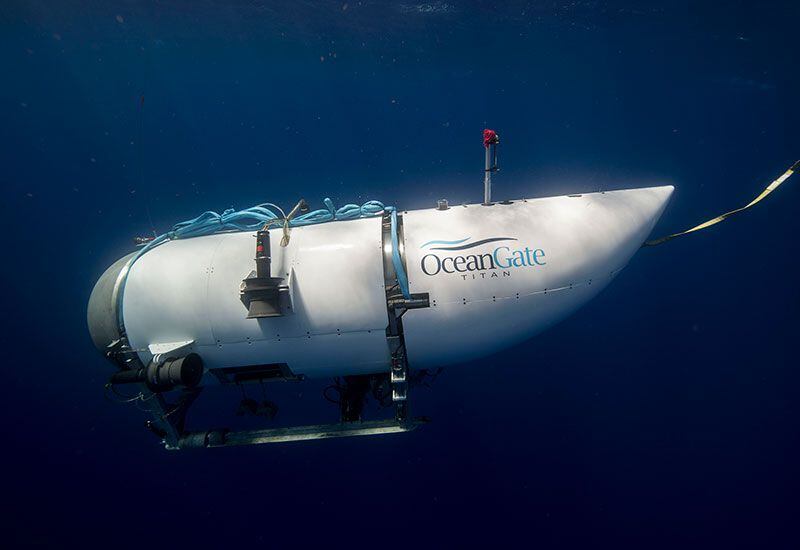Rescuers on Wednesday sent more boats and other craft to the spot where the Titan submersible disappeared on its way to the wreckage. titanichoping that the underwater sounds they detected for the second day in a row will help narrow the search area in an increasingly urgent mission.
Crews are concentrated in an area twice the size of Connecticut in waters with 4 kilometers deepreported Capt. Jamie Frederick of the US Coast Guard First District. Authorities still hope to rescue the five passengers from the plane alive. Titan.
LOOK: A billionaire, a father and his son, a renowned explorer: who are the 5 passengers on the Titanic submarine?
“This is 100% a search and rescue mission,” Fredrick said. “We will continue to put all the available assets that we have to find the Titan and to the crew members”.
But those who even expressed a bit of optimism warned that many hurdles still lay ahead: From finding the location of the submersibleup toreach him with a rescue team and bring him to the surfaceassuming it’s undamaged, and all that before the oxygen supply for passengers runs out, which some have estimated as early as Thursday morning.
The Titan is capable of reaching 4,000 meters deepwhile the remains of the titanic rest at 3,821 meters. Human beings are only capable of reaching these depths in submarines or submersible like the company OceanGate, which offers the tour for $250,000.
He Titanmissing on Sunday, could be on the surface of the Atlantic Oceanor at the bottom of the sea. At this point, National Geographic asked a valid question: Why can’t teams of divers go down to try and find the submersible? The answer is overwhelming: If a person decided to descend to those 3,821 meters, they would die before traveling a tenth of the descent.

National Geographic explains that when we submerge in the water and begin to go down, the first thing we will notice is a pressure difference in the ears. This from 5 meters. He pain in the ear it can be neutralized if we cover our mouths and noses and try to expel the air.
LOOK: Why is it so difficult to find the missing Titan submersible in the Atlantic when it was going to explore the Titanic
To continue descending, it is required to be equipped with a diving equipment. According to National Geographic, the most basic recreational diving is practiced up to 18 meters deep, but can go up to 40 meters with the right level. This diving requires training, since the gases we breathe also behave differently at higher pressure.
From a depth of 30 meters, a process called nitrogen narcosis, indicates National Geographic.
“By breathing compressed air, the total amount of air stored in the tissues increases. This causes changes in the delicate balance that we have within us and interferes with normal metabolic processes, especially in our most complex organ: the brain. According to what is known as Martini Lawonce you descend 20 meters, every 10 meters deeper the body suffers a poisoning similar to the consumption of a Martini”, specifies the magazine.
As it descends, bad decisions begin to be made, we go into a state of euphoria, there is a headache, disorientation and even loss of consciousness, something that at these depths can mean death. “Loss of consciousness usually occurs after 90 metersso there would still be 3,730 meters to the titanic”.
But before you get to that point, those effects can be avoided by using other gases in the bottles. divebut this has its downside, because the oxygen itself becomes toxic, warns National Geographic.
At 60 meters, the air that is breathed from the bottle is 7 times more dense than that on the surface, so the air begins to become toxic. Divers can continue to descend because they use special and meticulously studied gas mixtures.
At depths greater than 120 to 180 meters, a high pressure neurological syndrome, that causes neurological problems similar to previous poisonings, and the most serious consequence would be death.
At this point, we stay at 180 meters. But to move on National Geographic remember that there are world records for real and simulated immersion.
The scuba diving record is held by Ahmed Gabr, a former Egyptian soldier who, in 2014, it descended to a depth of 332.35 meters in 12 minutes. After this, it took him more than 15 hours to get back up.
In the field of technical diving, the record is held by a team from the COMEX company, which in 1988 repaired a pipeline 534 meters deep.
In 1992, the company COMEX started the Hydra X project, where they used a hyperbaric chamber out of water to simulate pressure at 701 meters, where the simulated diver was able to test new gas mixtures. The experiment set the world record for simulated diving. If this successful test is transferred to the sea, there would still be more than 3,000 meters to reach the Titanic.
There’s no more. What follows for the human being is to appeal to submarines or submersibles like the Titan to get to the titanic. The structure of these devices supports the pressure of the water column, so the air inside is at atmospheric pressure and can be breathed normally.
With one of these submarines, the Deepsea Challenger, which was built in collaboration with National Geographic, Film director James Cameron reached the bottom of the Mariana Trench in 2012, at a depth of 10,898.4 meters, quite a feat.

Source: Elcomercio
I am Jack Morton and I work in 24 News Recorder. I mostly cover world news and I have also authored 24 news recorder. I find this work highly interesting and it allows me to keep up with current events happening around the world.

:quality(75)/cloudfront-us-east-1.images.arcpublishing.com/elcomercio/FWNWNAGGZJG57AZFKYRL56DC4M.jpg)



:quality(75)/cloudfront-us-east-1.images.arcpublishing.com/elcomercio/BUNML4TQNVHSBOBMY5FC3QEM2M.jpg)

